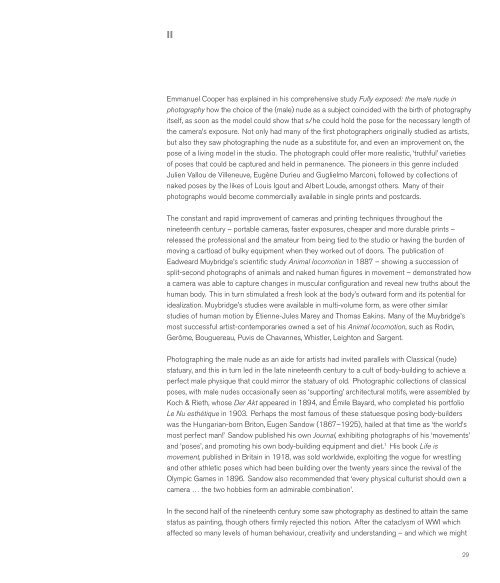Vaughan_book
You also want an ePaper? Increase the reach of your titles
YUMPU automatically turns print PDFs into web optimized ePapers that Google loves.
II<br />
Emmanuel Cooper has explained in his comprehensive study Fully exposed: the male nude in<br />
photography how the choice of the (male) nude as a subject coincided with the birth of photography<br />
itself, as soon as the model could show that s/he could hold the pose for the necessary length of<br />
the camera’s exposure. Not only had many of the first photographers originally studied as artists,<br />
but also they saw photographing the nude as a substitute for, and even an improvement on, the<br />
pose of a living model in the studio. The photograph could offer more realistic, ‘truthful’ varieties<br />
of poses that could be captured and held in permanence. The pioneers in this genre included<br />
Julien Vallou de Villeneuve, Eugène Durieu and Guglielmo Marconi, followed by collections of<br />
naked poses by the likes of Louis Igout and Albert Loude, amongst others. Many of their<br />
photographs would become commercially available in single prints and postcards.<br />
The constant and rapid improvement of cameras and printing techniques throughout the<br />
nineteenth century – portable cameras, faster exposures, cheaper and more durable prints –<br />
released the professional and the amateur from being tied to the studio or having the burden of<br />
moving a cartload of bulky equipment when they worked out of doors. The publication of<br />
Eadweard Muybridge’s scientific study Animal locomotion in 1887 – showing a succession of<br />
split-second photographs of animals and naked human figures in movement – demonstrated how<br />
a camera was able to capture changes in muscular configuration and reveal new truths about the<br />
human body. This in turn stimulated a fresh look at the body’s outward form and its potential for<br />
idealization. Muybridge’s studies were available in multi-volume form, as were other similar<br />
studies of human motion by Étienne-Jules Marey and Thomas Eakins. Many of the Muybridge’s<br />
most successful artist-contemporaries owned a set of his Animal locomotion, such as Rodin,<br />
Gerôme, Bouguereau, Puvis de Chavannes, Whistler, Leighton and Sargent.<br />
Photographing the male nude as an aide for artists had invited parallels with Classical (nude)<br />
statuary, and this in turn led in the late nineteenth century to a cult of body-building to achieve a<br />
perfect male physique that could mirror the statuary of old. Photographic collections of classical<br />
poses, with male nudes occasionally seen as ‘supporting’ architectural motifs, were assembled by<br />
Koch & Rieth, whose Der Akt appeared in 1894, and Émile Bayard, who completed his portfolio<br />
Le Nu esthétique in 1903. Perhaps the most famous of these statuesque posing body-builders<br />
was the Hungarian-born Briton, Eugen Sandow (1867–1925), hailed at that time as ‘the world’s<br />
most perfect man!’ Sandow published his own Journal, exhibiting photographs of his ‘movements’<br />
and ‘poses’, and promoting his own body-building equipment and diet. 1 His <strong>book</strong> Life is<br />
movement, published in Britain in 1918, was sold worldwide, exploiting the vogue for wrestling<br />
and other athletic poses which had been building over the twenty years since the revival of the<br />
Olympic Games in 1896. Sandow also recommended that ‘every physical culturist should own a<br />
camera … the two hobbies form an admirable combination’.<br />
In the second half of the nineteenth century some saw photography as destined to attain the same<br />
status as painting, though others firmly rejected this notion. After the cataclysm of WWI which<br />
affected so many levels of human behaviour, creativity and understanding – and which we might<br />
29


